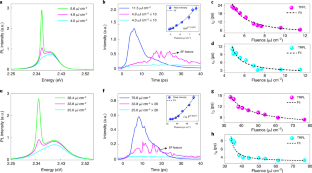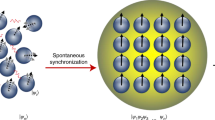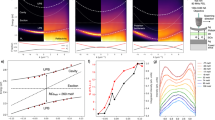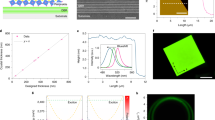Abstract
The formation of coherent macroscopic states and the manipulation of their entanglement using external stimuli are essential for emerging quantum applications. However, the observation of collective quantum phenomena such as Bose–Einstein condensation, superconductivity, superfluidity and superradiance has been limited to extremely low temperatures to suppress dephasing due to random thermal agitations. Here we report room-temperature superfluorescence in hybrid perovskite thin films. This surprising discovery shows that in this material platform, there exists an extremely strong immunity to electronic dephasing due to thermal processes. To explain this observation, we propose that the formation of large polarons in hybrid perovskites provides a quantum analogue of vibration isolation to electronic excitation and protects it against dephasing even at room temperature. Understanding the origins of sustained quantum coherence and the superfluorescence phase transition at high temperatures can provide guidance to design systems for emerging quantum information technologies and to realize similar high-temperature macroscopic quantum phenomena in tailored materials.
This is a preview of subscription content, access via your institution
Access options
Access Nature and 54 other Nature Portfolio journals
Get Nature+, our best-value online-access subscription
$29.99 / 30 days
cancel any time
Subscribe to this journal
Receive 12 print issues and online access
$209.00 per year
only $17.42 per issue
Buy this article
- Purchase on Springer Link
- Instant access to full article PDF
Prices may be subject to local taxes which are calculated during checkout




Similar content being viewed by others
Data availability
Source data are provided with this paper. All other data that support the plots within this paper and other findings of this study are available from the corresponding author upon reasonable request.
Change history
14 April 2022
A Correction to this paper has been published: https://doi.org/10.1038/s41566-022-00997-x
References
Bergmann, M. & Gühne, O. Entanglement criteria for Dicke states. J. Phys. A 46, 385304 (2013).
Tóth, G. & Apellaniz, I. Quantum metrology from a quantum information science perspective. J. Phys. A 47, 424006 (2014).
Eastham, P. R. & Rosenow, B. in Universal Themes of Bose-Einstein Condensation (eds Proukakis, N. et al.) 462–476 (Cambridge Univ. Press, 2017).
Dai, D. & Monkman, A. Observation of superfluorescence from a quantum ensemble of coherent excitons in a ZnTe crystal: evidence for spontaneous Bose–Einstein condensation of excitons. Phys. Rev. B 84, 115206 (2011).
Noe, G. T. II et al. Giant superfluorescent bursts from a semiconductor magneto-plasma. Nat. Phys. 8, 219–224 (2012).
Florian, R., Schwan, L. O. & Schmid, D. Two-color superfluorescence of O2-centers in KCl. J. Lumin. 31–32, 169–171 (1984).
Miyajima, K., Kagotani, Y., Saito, S., Ashida, M. & Itoh, T. Superfluorescent pulsed emission from biexcitons in an ensemble of semiconductor quantum dots. J. Phys. Condens. Matter 21, 195802 (2009).
Rainò, G. et al. Superfluorescence from lead halide perovskite quantum dot superlattices. Nature 563, 671–675 (2018).
Findik, G. et al. High-temperature superfluorescence in methyl ammonium lead iodide. Nat. Photon. 15, 676–680 (2021).
Malcuit, M. S., Maki, J. J., Simkin, D. J. & Boyd, R. W. Transition from superfluorescence to amplified spontaneous emission. Phys. Rev. Lett. 59, 1189 (1987).
Miyajima, K., Kumagai, Y. & Ishikawa, A. Ultrashort radiation of biexcitonic superfluorescence from high-density assembly of semiconductor quantum dots. J. Phys. Chem. C 121, 27751–27757 (2017).
Okada, J., Ikeda, K. & Matsuoka, M. Streak camera investigation of superradiance development. Opt. Commun. 27, 321–323 (1978).
Kumarakrishnan, A. & Han, X. Superfluorescence from optically trapped calcium atoms. Phys. Rev. A 58, 4153 (1998).
Dai, D. Brief comment: Dicke superradiance and superfluorescence find application for remote sensing in air. Preprint at https://arxiv.org/abs/1108.5360 (2011).
Siegman, A. E. Lasers (Univ. Science Books, 1986).
Benedict, M. G. Super-Radiance: Multiatomic Coherent Emission (CRC Press, 1996).
Ariunbold, G. O., Sautenkov, V. A., Rostovtsev, Y. V. & Scully, M. O. Ultrafast laser control of backward superfluorescence towards standoff sensing. Appl. Phys. Lett. 104, 021114 (2014).
Burnham, D. C. & Chiao, R. Y. Coherent resonance fluorescence excited by short light pulses. Phys. Rev. 188, 667 (1969).
Jiang, Y., Wei, J. & Yuan, M. Energy-funneling process in quasi-2D perovskite light-emitting diodes. J. Phys. Chem. Lett. 12, 2593–2606 (2021).
Yuan, M. et al. Perovskite energy funnels for efficient light-emitting diodes. Nat. Nanotechnol. 11, 872–877 (2016).
Haake, F., King, H., Schröder, G., Haus, J. & Glauber, R. Fluctuations in superfluorescence. Phys. Rev. A 20, 2047 (1979).
Traverso, A. J. et al. Coherence brightened laser source for atmospheric remote sensing. Proc. Natl Acad. Sci. USA 109, 15185–15190 (2012).
Yuan, L. et al. Theoretical analysis of the coherence-brightened laser in air. Phys. Rev. A 87, 023826 (2013).
Rai, J. & Bowden, C. M. Quantum-statistical analysis of superfluorescence and amplified spontaneous emission in dense media. Phys. Rev. A 46, 1522 (1992).
Ariunbold, G. O., Sautenkov, V. A. & Scully, M. O. Quantum fluctuations of superfluorescence delay observed with ultrashort optical excitations. Phys. Lett. A 376, 335–338 (2012).
Maki, J. J., Malcuit, M. S., Raymer, M. G., Boyd, R. W. & Drummond, P. D. Influence of collisional dephasing processes on superfluorescence. Phys. Rev. A 40, 5135 (1989).
Nasu, M., Kawamura, K., Yoshida, T., Ishihara, J. & Miyajima, K. Influences of quantum fluctuation on superfluorescent spectra observed by single-shot measurement for semiconductor quantum dots. Appl. Phys. Express 13, 062005 (2020).
Miyata, K. et al. Large polarons in lead halide perovskites. Sci. Adv. 3, e1701217 (2017).
Zhu, X. Y. & Podzorov, V. Charge carriers in hybrid organic–inorganic lead halide perovskites might be protected as large polarons. J. Phys. Chem. Lett. 6, 4758–4761 (2015).
Monahan, D. M. et al. Room-temperature coherent optical phonon in 2D electronic spectra of CH3NH3PbI3 perovskite as a possible cooling bottleneck. J. Phys. Chem. Lett. 8, 3211–3215 (2017).
Lan, Y. et al. Ultrafast correlated charge and lattice motion in a hybrid metal halide perovskite. Sci. Adv. 5, eaaw5558 (2019).
Thouin, F. et al. Phonon coherences reveal the polaronic character of excitons in two-dimensional lead halide perovskites. Nat. Mater. 18, 349–356 (2019).
Long, H. et al. Exciton–phonon interaction in quasi-two dimensional layered (PEA)2(CsPbBr3)n−1PbBr4 perovskite. Nanoscale 11, 21867–21871 (2019).
Sonnichsen, C. D., Strandell, D. P., Brosseau, P. J. & Kambhampati, P. Polaronic quantum confinement in bulk CsPbBr3 perovskite crystals revealed by state-resolved pump/probe spectroscopy. Phys. Rev. Res. 3, 023147 (2021).
Puppin, M. et al. Evidence of large polarons in photoemission band mapping of the perovskite semiconductor CsPbBr3. Phys. Rev. Lett. 124, 206402 (2020).
Chan, C. C. et al. Uncovering the electron‐phonon interplay and dynamical energy‐dissipation mechanisms of hot carriers in hybrid lead halide perovskites. Adv. Energy Mater. 11, 2003071 (2021).
Emin, D. Polarons (Cambridge Univ. Press, 2012).
Acknowledgements
We acknowledge helpful discussions with H. Ade (North Carolina State University (NCSU)). We also acknowledge the NCSU Imaging and Kinetic Spectroscopy facility. K.G. and F.S. acknowledge funding from the National Science Foundation’s ‘Designing Materials to Revolutionize and Engineer our Future’ programme (grant no. 1729383) and the NCSU Research and Innovation Seed Funding (RISF).
Author information
Authors and Affiliations
Contributions
K.G. conceived the research problems and QAVI model and coordinated the studies. M.B. and G.F. performed the PL, TRPL and pump–probe experiments, as well as analysed the results. D.S. assisted with the pump–probe experiments, and J.M. assisted with the TRPL experiments. L.L., Q.D., J.M. and F.S. provided the samples. Y.M. performed the atomic force microscopy experiment. V.V.T. performed the theoretical simulations. K.G. drafted the manuscript with the help of M.B. and G.F. All the authors helped with editing the manuscript.
Corresponding author
Ethics declarations
Competing interests
The authors declare no competing interests.
Peer review
Peer review information
Nature Photonics thanks the anonymous reviewers for their contribution to the peer review of this work.
Additional information
Publisher’s note Springer Nature remains neutral with regard to jurisdictional claims in published maps and institutional affiliations.
Supplementary information
Supplementary Information
Supplementary Sections 1–4 and Figs. 1–29.
Source data
Source Data Fig. 1
Source data for graphs.
Source Data Fig. 2
Source data for graphs.
Source Data Fig. 3
Source data for graphs.
Rights and permissions
About this article
Cite this article
Biliroglu, M., Findik, G., Mendes, J. et al. Room-temperature superfluorescence in hybrid perovskites and its origins. Nat. Photon. 16, 324–329 (2022). https://doi.org/10.1038/s41566-022-00974-4
Received:
Accepted:
Published:
Issue Date:
DOI: https://doi.org/10.1038/s41566-022-00974-4
This article is cited by
-
Observation of transition from superfluorescence to polariton condensation in CsPbBr3 quantum dots film
Light: Science & Applications (2024)
-
Neuromorphic computing based on halide perovskites
Nature Electronics (2023)
-
Structured air lasing of N2+
Communications Physics (2023)



